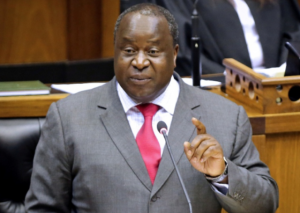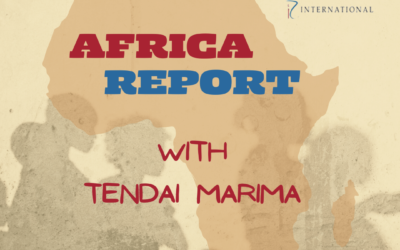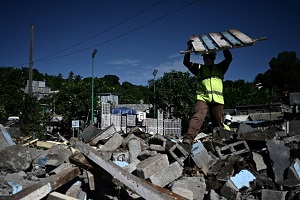Faizel Patel – 24/06/2020

Madam Speaker
Mr President
Mr Deputy President
Cabinet Colleagues
Governor of the South African Reserve Bank
Members of the Executive Committees for Finance
Honourable Members
Fellow South Africans
Molweni
Today, I hereby table for the consideration of the House:
- The Division of Revenue Amendment Bill
- Adjustments Appropriation Bill
- Supplementary Budget Review
- Disaster Management Tax Relief Bill
- Disaster Management Tax Relief Administration Bill
1. INTRODUCTION
Madam Speaker,
We are in the midst of a fast‐evolving pandemic.
In South Africa and around the world, we have made the decision to protect each other. We have quickly adapted.
We all now wear masks. We wash our hands more often. We maintain a safe social distance. As a result, millions have stayed safe. We remain deeply concerned about the path of the virus. But, in common with several other countries that adopted a stringent, early lockdown, we have “flattened the curve” and saved lives.
As the wise farmer will tell you, when the tempest is raging you must protect your plants from damage. Our Aloe Ferox, like our people, is protected. Mr President, you are the wise farmer, caring for this Aloe Ferox.
The storm is not over. But, if we follow the health guidelines and make the right decisions to prepare for a new global reality then, soon enough, the days will grow calmer and our national Aloe Ferox shall go into the new day healthy and strong.
Liduma lidlule!
The storm shall pass!
1.1. THE PURPOSE OF THE SUPPLEMENTARY BUDGET
Honourable members,
The Public Finance Management Act, read together with the Money Bills Amendment Procedure and Related Matters Act, empowers me, as the Minister of Finance, to table an adjustments budget when necessary.
The historic nature of this pandemic and economic downturn has made it necessary to table such an adjustment.
We will table a second adjustments budget in October together with the Medium‐Term Budget Policy Statement.
This Budget does two things.
First, it brings an Adjustments Appropriation Bill and a Division of Revenue Amendment Bill to the House. It also formalises the two tax bills to give effect to our response. These Bills ask Parliament to approve the response package for COVID‐19.
Second, Mr President, it lays a path for the direction you gave us on 21 April to:
“not merely return our economy to where it was before the coronavirus, but to forge a new economy in a new global reality”
This Supplementary Budget sets out a roadmap to stabilise debt, by improving our spending patterns, and creating a foundation for economic revival.
Most of our energies and resources have been focused on the COVID‐19 pandemic. We have quickly adopted temporary countercyclical fiscal and monetary policy measures. After the storm ends, we must work just as quickly to emerge with a sustainable fiscus.
We have many strengths. These include our young and ambitious people; Our institutions, a robust and vibrant democracy, independent judiciary and our commitment to social justice progress; and our economic strengths: a diverse industrial base, a flexible exchange rate, stable inflation, and deep domestic capital markets that allow us to borrow mainly in rand.
But debt is our weakness. We have accumulated far too much debt; this downturn will add more. This year, out of every rand that we pay in tax, 21 cents goes to paying the interest on our past debts.
This indebtedness condemns us to ever higher interest rates. If we reduce debt, we will reduce interest rates for everyone and we will unleash investment and growth.
So today, with an eye on the future, we set out a strategy to build a bridge to recovery.
Our Herculean task is to close the mouth of the Hippopotamus!
It is eating our children’s inheritance. We need to stop it now!
Our Herculean task is to stabilise debt.
2. IN‐YEAR ADJUSTMENTS
2.1. THE ECONOMIC OUTLOOK
Let me begin by outlining our updated fiscal and economic forecasts for the current fiscal year.
COVID‐19 has turned the global economy upside down. In the February Budget, we expected that the global economy would expand by 3.3 per cent in 2020. We now expect a global contraction of 5.2 per cent this year. This will bring about the broadest collapse in per capita incomes since 1870. Throughout the world, tens of millions of workers have lost their jobs. South African unemployment increased by one percentage point, reaching 30.1 per cent in the first three months of this year.
The South African economy is now expected to contract by 7.2 per cent in 2020. This is the largest contraction in nearly 90 years. Inflation will likely register 3 per cent in 2020, in line with the outcome of this morning. Commodity price increases and a weaker oil price have softened the blow, but as a small open economy reliant on exports we have been hit hard by both the collapse in global demand and the restrictions to economic activity.
2.2. FISCAL, MONETARY AND OTHER MEASURES
South Africa has responded to this economic shock with an unprecedented set of measures.
Never before has government worked together so closely with the private sector, labour, community and the central bank. Standing as a united people, it is clear we can achieve anything. Government’s COVID‐19 economic support package directs R500 billion straight at the problem. This is one of the largest economic response packages in the developing world. The South African Reserve Bank has reduced interest rates and made it easier for banks to lend money. The SARB has also supported liquidity in the domestic bond market. The Bank has stated that it stands ready to take additional action, should the need arise. More than 2 million customers have received around R30 billion in relief from their commercial banks. Insurers and medical aid schemes have provided premium holidays. Landlords have provided rental relief. All in 100 days. This is indeed a remarkable achievement.
2.2.1. REVISED FISCAL FRAMEWORK FOR 2020/21
Turning to the emerging fiscal framework for 2021/22.
Honourable members, projected total consolidated budget spending, including debt service costs, will exceed R2 trillion for the first time ever.
Gross tax revenue collected during the first two months of 2020/21 was R142 billion, compared to our initial forecast for the same period of R177.3 billion. Put another way – we are already R35.3 billion behind on our 2020/21 target.
As a consequence, gross tax revenue for the 2020/21 fiscal year is revised down from R1.43 trillion to R1.12 trillion.
That means that we expect to miss our tax target for this year by over R300 billion.
Part of this revision is because the measures announced earlier this year give taxpayers outright relief of R26 billion and delays in tax collection of approximately R44 billion. These proposals are contained in the Disaster Management Tax Relief Bill and the Disaster Management Tax Relief Administration Bill that I table today.
Taken together the measures and adjustments we present translate into a consolidated budget deficit of R761.7 billion, or 15.7 per cent of GDP in 2020/21. This is compared to the deficit of R370.5 billion, or 6.8 per cent of GDP projected in February. This increase is mainly due to the revised revenue projections and pay‐outs from the Unemployment Insurance Fund. The narrower measure, known as the main budget deficit, is projected to be 14.6 per cent of GDP.
Our early projection is that gross national debt will be close to R4 trillion, or 81.8 per cent of GDP by the end of this fiscal year. This is compared to an estimate of R3.56 trillion or 65.6 per cent of GDP projected in February.
Without external support, these borrowings will almost entirely consume all of our annual domestic saving, leaving no scope for investment or borrowing by anyone else. For this reason, we need to access new sources of funding.
Government intends to borrow about US$7 billion from international finance institutions to support the pandemic response. We must make no mistake, these are still borrowings. They are not a source of revenue. They must be paid back.
2.2.2. HEALTH AND FRONTLINE SERVICES
The Supplementary Budget proposes R21.5 billion for COVID‐19‐related health care spending. It also proposes a further allocation of R12.6 billion to services at the frontline of our response to the pandemic. Allocations have been informed by epidemiological modelling, a national health sector COVID‐19 cost model and our experiences over the past 100 days.
This money partly supports increased screening and testing, allowing us to open up more and more of the economy.
We have successfully increased our COVID‐19 bed capacity to above 27 000; identified 400 quarantine sites with a capacity of around 36 000 beds across the country and deployed nearly 50 000 community health care workers to screen millions of South Africans. We have tested over 1.3 million people.
Provinces will add at least R5 billion for the education catch‐up plan, social welfare support for communities and provision of quarantine sites by Public Works departments and responses in other sectors. we salute all the brave health care and essential service workers who are leading this fight.
Tariffs have been agreed with private hospitals to supplement public sector capacity.
The Solidarity Fund has augmented government’s efforts to procure medical and personal protective equipment.
We thank all those who have made much needed contributions to the Fund.
These examples show that working together with the private sector with a common purpose we can get stuff done.
We will use these lessons to re‐energise public‐private partnerships.
2.2.3. PROTECTING THE MOST VULNERABLE
Madam Speaker,
Over 18 million South Africans have received a temporary COVID‐19 grant. The roll out of the short‐term Special Relief of Distress grant will temporarily support those without an income. An additional 1.5 million people have received these already. To support vulnerable households an additional allocation of R25.5 billion to the Social Development department is proposed, for a total relief package of R41 billion.
All these measures will come to an end in October.
We have implemented health and hygiene measures in 7 000 early childhood development centres, and appointed about additional 1 800 social workers.
2.2.4. DRIVING JOB CREATION
The figures from yesterday show that unemployment is our single greatest challenge. The Economic Support Package sets aside R100 billion for a multi‐year, comprehensive response to our jobs emergency.
The President’s job creation and protection initiative will be rolled out over the medium‐term. It will include a repurposed public employment programme and a Presidential Youth Employment Intervention. In this year, an amount of R6.1bn is already allocated, and a further R19.6 billion has been set aside mainly for this purpose.
2.2.5. UNEMPLOYMENT INSURANCE
As of mid‐June, the Unemployment Insurance Fund (UIF) has provided R23 billion in COVID‐19 relief to over 4.7 million workers affected by the pandemic.
This has required a huge upgrade and repurposing of the UIF system to deal with the increase in mostly online applications, and to build in protections against fraud. We thank all involved for the upgrade, there were many individuals from the private and NGO sector who volunteered their time to assist the UIF. There are still challenges but we are confident that the team is working tirelessly to iron them out.
2.2.6. CHANGES TO THE DIVISION OF REVENUE
Honourable members, the division of revenue presented in the 2020 Budget is revised as follows: the national share for 2020/21 increases from R758 billion to R790 billion, the provincial share decreases from R649 billion to R645 billion and the local government share increases from R133 billion to R140 billion.
Local government is at the heart of our response to the pandemic. Accordingly, an additional R11 billion is allocated to local government through the equitable share. A further R9 billion will be reprioritised within allocated conditional grants to fund additional water and sanitation provision and the sanitisation of public transport.
Municipalities will adjust their budgets to take into account the sharp decline in revenue as a result of the pandemic. We urge communities to hold councils accountable for the spending of COVID‐19 funds.
National Treasury will also monitor the spending through monthly and quarterly reports.
2.2.7. COVID‐19 LOAN GUARANTEE SCHEME
Madam Speaker, after a slow start, including all the detailed and technical legal preparations, the loan guarantee scheme is expanding rapidly. In its first month, the scheme lent over R10 billion. Many more applications are being processed, and lending is expected to rise significantly.
Now that we have moved to an advanced Level 3, most of the economy is “open for business”. We must help businesses to get moving! The loan guarantee scheme also includes a business restart option, for businesses who need support to get up and going after the lockdown. This will apply to all businesses including those with turnover of more than R300 million.
We are also finalising amendments to the repayment holiday and turnover limit, and relaxing terms and conditions to support lending. The South African Reserve Bank and the commercial banks are finalising the revised legal arrangements and will make announcements shortly. Work is also continuing to expand the scheme to non‐bank lenders.
3. BUILDING A BRIDGE TO THE FUTURE
Madam Speaker, I now turn to the second part of this Supplementary Budget, which is to lay before the House the steps we are taking towards the MTBPS.
3.1. THE PATH FORWARD
The gospel according to the Apostle Matthew, chapter 7 verses 13 and 14, springs to mind:
Enter through the narrow gate. For wide is the gate and broad is the road that leads to destruction, and many enter through it. 14 But small is the gate and narrow the road that leads to life, and only a few find it.
We are faced, as a nation with a choice between these two gates. Even as South Africa responds to the current health and economic crisis, a fiscal reckoning looms. The public finances are dangerously overstretched.
The wide gate is a passive country that lets circumstances overwhelm it.
If we remain passive, economic growth will stagnate. Our debt will spiral inexorably upwards and debt‐service costs will crowd out public spending on education and other policy priorities. We already spend as much on debt‐service cost as we do on Health in this financial year. Eventually the gains of the democratic era would be lost.
The wide gate opens to a path of bankruptcy. A sovereign debt crisis1 is when a country can no longer pay back the interest or principal on its borrowings. We are still some way from that. But if we do not act now, we will shortly get there.
The results are devastating. Interest rates sky‐rocket. Spending has to stop. Inflation takes hold and people grow much poorer. This is what happened to Germany in the 1920s, to Argentina and to Zimbabwe in the early 2000s, and to Greece in the past few years. Argentina had its ships attached. Greek civil servants and pensioners had their salaries and pensions slashed. In short it is doom and despair. We have been there before: in its closing days, the Apartheid government had to declare a debt standstill.
We firmly reject this gate!
The narrow gate on the other hand opens to a path of prosperity.
Through this gate, we reduce our reliance on borrowing. We feed the hungry. We look after the sick. We educate our people. We build for the future. We spend with wisdom, and we jail those who loot.
The narrow gate is an active approach – a nation that takes active steps to rapidly stabilise debt and grow the economy. By doing this we will create jobs, reduce the cost of doing business and build a competitive economy.
3.2. DEBT STABILISATION THROUGH ZERO‐BASED BUDGETING
Cabinet, under the leadership and guidance of the President, has found the narrow gate. Government shall go through it.
Government will narrow the deficit and stabilise debt at 87.4 percent of GDP in 2023/24. Cabinet has also adopted a target of a primary surplus by 2023/24.
This is about the same time that our Aloe Ferox will flower for the first time. As any farmer will tell you ‐ patience and focus are required!
The Medium Term Expenditure Framework process will be guided by the principles of zero‐based budgeting which will be applied as a series of overlapping evaluation exercises targeted at large programmes. Our current system of Public Expenditure Reviews is a step towards zero‐based budgeting. This means that we will try to reduce all expenditure that we thought we can no longer afford. After all, we are not as rich as we were ten years ago.
The upcoming MTEF will pilot this approach.
In the review accompanying this budget we set out our initial proposed fiscal path for the period ahead. We need to find spending adjustments of about R230 billion over the next two years. Tax measures of R40 billion over the next 4 years will also be required. The Government will announce details to these tax proposals in the 2021 Budget.
Government will also be allocating R3 billion to recapitalise the Land Bank. This Bank holds 29 per cent of South Africa’s agricultural debt. The National Treasury is supporting the Land Bank find a solution to its default and craft a long‐term restructuring plan. Details on this recapitalisation are provided in the Supplementary Budget Review.
3.3. ALIGNING SPENDING TO THE STRUCTURAL REFORM AGENDA
A firm policy basis has been laid by Towards an Economic Strategy for South Africa, which was considered by Cabinet and accepted last year. While some of the measures have been delayed by the virus, we are now ready.
Deputy Minister Masondo will coordinate implementation as the head of the Vulindlela office.
One of these is to shift away from the electricity supply system that was introduced in 1923, when George V, the Queen’s grandfather, was the King of what was known as the Union of South Africa. The last few years have shown the inefficiency of this archaic system. Provisional allocations to Eskom were made on the understanding that Government’s Electricity Roadmap would be implemented.2 Progress is slow. The principle of zero‐based budgeting is that we must see demonstrable value for money: Eskom will need to show progress in meeting the milestones as laid down in the Roadmap.
This is non‐negotiable.
Progress on the other reforms will be given in the MTBPS.
3.4. FAIR AND FISCALLY SUSTAINABLE PUBLIC SECTOR COMPENSATION
This year nearly half of all consolidated revenue will go towards the compensation of workers in the public. We value the important work public servants do.
Minister Senzo Mchunu is negotiating with our partners in the labour movement to find a balanced solution that sets compensation at an appropriate, affordable and fair level.
We wish him well.
3.5. PUTTING INFRASTRUCTURE AT THE CENTRE OF GROWTH
Finally, Honourable members, building a bridge to a post‐lockdown future will require that we build high‐quality physical bridges, roads, railways, ports and other infrastructures.
Infrastructure will be the fly wheel by which we grow the economy. Just as we have toiled together to manage the pandemic, let us harness this same unity of purpose and build the infrastructure our nation needs. Our efforts to reduce consumption expenditure will also change the composition of spending in the direction of investment.
Yesterday, the Presidency hosted a successful Sustainable Infrastructure Development Symposium, drawing in sector specialists, technical and financial structuring experts and policy departments that have considered 177 infrastructure projects across public and private sectors.
In light of these and other important initiatives, the Government has already committed R100 billion over ten years toward the Infrastructure Fund.
Together with the Development Bank of Southern Africa, we have identified projects that will be funded through the Budget Facility for Infrastructure. We have recently released a paper on Sustainable Finance, and we are working closely with the private sector to green our economy.
But our enormous investment needs cannot be delivered by government alone. The private sector accounts for most of the investment spending in the economy. We must reduce long‐term interest rates to allow business and households to drive faster economic growth.
4. CONCLUSION
This is my presentation to the House and to South Africa, an extraordinary Supplementary Budget that saves lives, protects livelihoods and actively builds a bridge to a prosperous future.
Madam Speaker, the Gospel tells us:
Small is the gate and narrow the road that leads to life, and only a few find it.
Let me pay tribute to the South Africans who through their actions have protected the health and lives of their fellow citizens. They show resolve to go through the narrow road. Their government is ready to follow their lead.
To quote the President, in his letter to the nation on Monday:
Let us put shoulder to the wheel and turn this adversity into opportunity.
Let us reimagine and repurpose our economy and put it firmly on a solid and sustainable path.
In conclusion,
Mr President and Deputy President, thank you for your leadership.
Thank you to the Deputy Minister of Finance, the National Treasury Director General and his team for their insightful contributions!
My thanks to the Commissioner of the South African Revenue Service, to the Governor of the South African Reserve Bank, to colleagues in the Cabinet, in the Ministers Committee on the Budget and all the MECs that we have worked so closely with.
My gratitude for the Parliamentary Committees who work tirelessly to process the legislation accompanying the Speech.
Fellow South Africans, Matthew chapter 7 closes as follows:
“Everyone who hears these words of mine and puts them into practice is like a wise person who built their house on the rock. 25 The rain came down, the streams rose, and the winds blew and beat against that house; yet it did not fall, because it had its foundation on the rock.
Let us listen, let us practice and let us build!
I thank you.







0 Comments